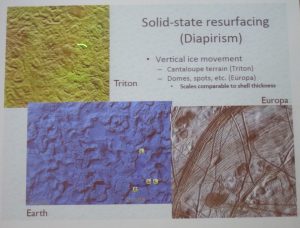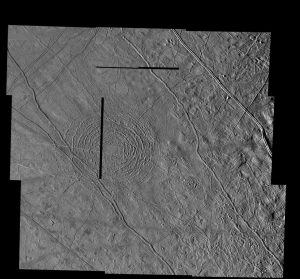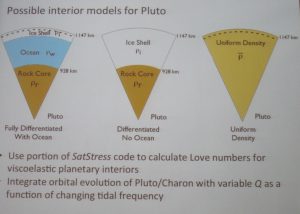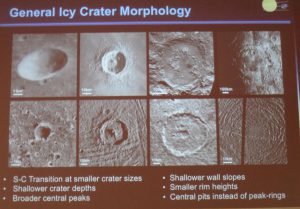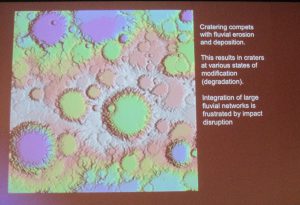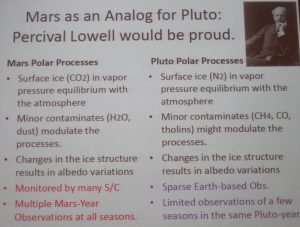This a blog entry for a series about the Pluto Science Conference being held at JHU’s APL in Laurel, MD, July 22-26, 2013. This entry summaries surface geology talks presented on July 25th.
Paul Schenk (LPI) began the session with his talk entitled “The Improbable Art of Predicting Pluto-Charon Geology.” Thanks to Voyager, Galileo and Cassini we have a wealth of knowledge about icy bodies in the solar system. However, in comparison to the icy satellites about Saturn, the Pluto-Charon bodies are expected to have key differences: volatile ice content is probably higher, their geological histories are not influenced by the existence of large giant planet near by (tidal forces), etc.
He asked, Is Pluto just another Triton? No. It may be similar in size and composition, but geology will be different. The main sources for heating for Pluto are assumed to be heating from radiogenic rock component (heating by radioactive decay) and energy from the giant impact that formed it. Is Charon one of many? Charon is of similar size to Uranian satellites Dione, Tethys, Ariel, Umbriel, but it may be that Charon-forming impact did not much impact much heating. In any event, all these icy satellites are diverse, from dead cold worlds to those with active erupting volcanoes, so in Paul Schenk’s words, “Who knows [what Charon will resemble]?”
He next stepped up through the key geological processes that would alter and/or create surface features. For example, volcanism creates smooth plains, calderas, vents, ridges, and active venting. Volcanic processes have been seen on many icy moons. There is diapirisim, a type of solid-state resurfacing due vertical ice movement. To have this process, you need an ice shell, preferably a thin shell with a source of heat. This is seen only two icy bodies in the solar system: Triton (“cantaloupe terrain”) and Europa (domes, spots). There is also tectonism, revealed through fractures.
Vertical movement is one of the processes creating unique features on Triton & Europa. The Earth shows this behavior (described above, called diapirism) in local regions of salt deposits.
He next pointed out the possibility that satellites could have rings too. For example, there is a giant ridge on Iapetus (Ip 2007) and a similar feature on Rhea (Schenk et al 2011). It is hypothesized that these surface features were the result of a ring that had collapsed onto the surface. His advice to the New Horizons team is to pay special attention to the Pluto-Charon equatorial regions to look for a ring-remnant.
Impact Cratering tells us about the impactor population that are “fluxing into the system,” reveals surface stratigraphy, reveals interior stratigraphy (what the underlying layers look like), and reveal thermal history. Counting crater impacts on Pluto & Charon will be used to evaluate the Kuiper Belt population.
Predictions for New Horizons. He expects craters to look like those found on Ganymede (simple craters) for Pluto and Dione & Thetys for Charon (craters with dominant peaks). Charon may be “bland geologically.”
What about viscous relaxed craters? They have been found on Ganymede & Enceladus. Crater shapes can be used to reveal the properties about the object. However, he added this caveat that all previous work on modeling crater shapes was on water ice dominated surfaces, not methane (which is expected on Pluto), so more lab work is needed. Basin morphologies are important too. They tell us about evolution. Anomalous morphologies are also a key thing to look for on Pluto & Charon.
The Tyre crater on Europa (one of Jupiter’s moons) fromhttp://www.lpi.usra.edu/science/kiefer/Education/SSRG2-Craters/europa_tyre.jpg.
Europa has these intriguing multi-ring systems, such as shown above with the image of Tyre crater. The hypothesis is that on Europa we are seeing an impact penetrating into the ice shell of 10-20 km. Crater falls in on its self, creating this ringed structure.
“There will be impact craters. We are going to be captivated. We are going to be befuddled.” – Paul Schenk
Geoffrey Collins (Wheaton College) “Predictions about Tectonics on Pluto and Charon.” His premise: “Tides raised by giant planets appear to be an important factor in icy satellite tectonics, but what about the Kuiper Belt?” He is interested in the time period after the initial Charon-forming impact. He and his colleagues have created models to calculate the interior viscosity for a range of Charon’s orbital evolution scenarios. They looked at the three main possible interior models for Pluto: (1) ice shell, ocean, rock core; (2) thick ice shell, rock core; and (3) uniform density. Another parameter they looked at was the formation distance of Charon from Pluto.
Possible interior models for Pluto are shown above: (left) ice-shell, ocean, core, (middle) thick ice-shell, core, (right) uniform density (undifferentiated).
Conclusions. Pluto will need to have an interior > 200 K. It is likely that due to tidal heating (when orbital and rotational energy are dissipated as heat in the crust, which would be happening for Pluto despinning after formation), Pluto would melt and differentiate. The most self-consistent models include an ocean.
Beau Bierhaus (SwRI) talked about “Crater and Ejecta Populations on Pluto and its Entourage.” Craters are the most abundant landform in the solar system. They tell us about the target on/in which they reside. By studying the numbers and sizes of craters, and assuming an estimated impact rate, one can use crater density to estimate surface age. They are also indirect indicators of the impactor and in the case of Pluto, this could tell us information about the Kuiper Belt makeup.
Mass ejected from a crater follows an inverse relationship with velocity. Less mass is ejected at higher velocities, but to have ejecta (the material thrown out after an impact), the speed has to be above a particular Vmin, minimum velocity. And if that velocity is lower than the escape velocity for an object (the speed above which would allow the object to escape the gravity well and go into orbit), you can create secondary craters. For ice, Vmin ~150-250 m/s. Pluto has Vescape ~1180 m/s; Charon has Vescape ~550 m/s. So we expect to see secondary craters on Pluto & Charon. Sesquinary craters might form when Vmin>> Vescape and the ejecta does escape the surface and then falls back onto its surface or onto another body. These are expected to be rare, but it’s possible you can have a crater formed on Pluto from a secondary ejected from Charon.
Predictions for New Horizons. Expect to see secondary craters on Pluto & Charon. Most of the craters will be primary impacts and they may have unusual morphology due to low impact speeds.
Veronica Bray (LPL, Arizona) continued the conversation with her talk on “Impact Crater Morphology on Pluto.” The crater morphology (shape) depends on properties of impactor and also the gravity and surface/subsurface of the receiving body. For Pluto, we expect the crater morphologies to match those expected for impacts to icy bodies: shallow wall slopes, smaller rim heights, and central pit instead of peak-rings.
Comparative crater morphology. Top row: Impact Craters on a rocky body (Earth’s Moon). Bottom Row: Impact craters on icy bodies. Left to right indicate increasing crater diameter. The multi-ring basin, shown at the bottom right, is the Tyre crater on Europa, hypothesized to be the remnant of an object that penetrated into the subsurface.
Lower impact velocity will provide less impact melt. New Horizons will resolve large and small-scale features. However, with respect to things like Isis-style floor pits, New Horizon’s best resolution is not high enough.
What will New Horizons data tell us? New Horizons will address answers to how velocity affects peak development and primary crater depth, central pit formation in relation to melt drainage, and the d/D (depth to Diameter) trend to address heat flow models over time.
Olivier Barnoiun (JHU/APL) talk was entitled “Surfaces Processes on the Moons of Pluto: Investigating the Effects of Gravity.” He is interested in processes on the smaller Pluto moons: Nix, Hydra, Kerberos, and Styx. He identified analogies in the solar system like 25413 Itokawa, a 100m asteroid that had been imaged by JAXA’s Hayabusa spacecraft in 2005. Hayabusa’s images revealed boulders that clustered together and were aligned; the leading hypothesis is that they were placed there by motion due to gravity. Other processes due to the presence of gravity, such as slope motions, are seen in the images. He notes that New Horizons will not have the resolution to duplicate the resolution Hayabusa had on Itokawa.
He and his colleagues have developed a computation “plate model” approach to tackle the motion of surface objects caused by “acceleration due to gravity” and this can be applicable to non-spherical bodies, for which Pluto’s smaller moons are highly suspected to be.
Marc Neveu (Arizona State University) asked “Exotic Sodas: Can Gas Exsolution Drive Explosive Cryovolcanism on Pluto and Charon?” Charon’s surface looks geologically young and could have an environment suitable for cryovolcanism. The term cryovolcanism was coined to explain the condition where the volcano erupts volatiles such as water, ammonia or methane, instead of molten rock . He presented a geochemical model where he has gas exiting a liquid as the mechanism for the cryovolcanism. The model involves the host liquid with different gas materials added and requires a crack in the surface ice layer. They also applied their model for a object that has a top crust; the crust acts like a “pressure seal” and prevents the gas from exsolving (separating from the liquid).
Lynnae Quick (JHU) presented some additional unique physics at Pluto with her talk on “Predictions for Cryovolcanic Flows on the Surface of Pluto.” She started with the statement that candidate bodies where cryovolcanism may be taking place are Enceladus, Europa, Titan and Triton. Imaging data from Voyager 2’s flyby of Neptune’s moon Triton provides strong evidence of cryovolcanism through interpretations of the terrain characterized by a lack of craters, geyser-like plume, walled plains, ring paterae (smooth circular), pit paterae, guttae (drop features). She and her colleagues are modeling the cooling of (surface) lava flows and used a variety of “candidate lava compositions,” mixtures of H2O, NH3, CH3OH, CO, CH4, N2 ices. They compute cooling time for variety of lava thicknesses and compositions.
Predictions for Plutonian Lavas. Their work suggests N2-CO and/or N2-CH4 lavas could have 62-68 K melting temperatures, so essentially they could stay “molten” on Pluto for long duration. They will need high-resolution topography of Pluto, Triton, and Io, lab data for 50-273 K and New Horizons imagery of Pluto data to advance their models.
Alan Howard (University of Virginia) spoke about “Landforms and Surface Processes on Pluto and Charon. ” He walked us through multiple ways to add and subtract material from a surface:Accrescenence is the addition (e.g., condensation) of material normal to the surfaces, resulting in outward facing surfaces getting rounded and inward faces surfaces being sharpened.Decrescence is the removal (e.g., sublimation) of material normal from the surface, resulting in the outward facing surfaces being sharpened, and inward faces getting smoothed. Mass wastingis the bulk movement of material downslope aided by gravity (e.g. avalanches, debris flow, landslides). Gas Geysers are caused when solar energy hits ice, heating the underlying surface that then expands and erupts through the surface. Aeolian (wind) processes form things like sand dunes. To address this complex series of multiple surface activities, landscape evolution modelshave been developed to model such these processes with time.
Result of a landscape evolution mode. Shown here is one result where large fluvial (flow) networks tend to get disrupted when you have a lot of impacting events.
Predictions for New Horizons. Expect to see scarps (steep banks) on the surface of Pluto. Expect to see the unexpected on Pluto and Charon.
Timothy Titus (USGS) gave a thought-provoking talk about using the “Mars Seasonal Caps as an Analog for Pluto: Jets, Fans, and Cold Trapping.” His premise is that the Mars’ polar processes are suitable analogs to explain what may be happening on Pluto. He stepped us through the Mars polar volatile transport model.
A key item is thermal inertia. On Mars the soil absorbs heat in summer, but high enough thermal inertia (200 MKS) to delay ice formation until late in the year, and this, as you would expect, affect the whole ‘ice cycle.’ There is a big disconnect in the community over what Pluto’s thermal inertia is. In E. Lellouch’s talk on Jul 23 (see earlier blog entry) he reported that Spitzer & Herschel have measured Pluto’s thermal inertia as 20-30 MKS (Lellouch et al 2011). However, Pluto atmosphere pressure models needed to match occultation by C. Olkin & L. Young require Pluto have a much higher thermal inertia >1000 MKS to explain their occultation measurements (presented at this meeting).
Thermal inertia is a measure of the ability of a material to conduct and store heat. In the context of planetary science, it is a measure of the subsurface’s ability to store heat during the day and reradiate it during the night. This has natural consequences for deriving what happens to processes that require an exchange of heat such as transport models. Thermal inertia measurements can also be used to infer types of surfaces, e.g. distinguish between fine dust/few rocks and coarse sand/many rocks. MKS is a short form for the units “J K-1 m-2 s-1/2.”
He makes a tantalizing comparison between the north/south asymmetry in the Mars polar ice caps due to topography and suggests whether this could possibly be an analog to why the methane and N2 have longitudinal distributions (shown yesterday in Will Grundy’s talk). Jets, plumes, fans, and spiders on Mars are results of active gas geyser activities. He postulates, could the same be occurring on Pluto? If we miss the gas/plume season, we could see the leftover signatures in fans and spiders.
Predictions for New Horizons. Asymmetric seasonal caps. Methane lags surrounding the N2 seasonal cap. Optically thick layers of methane on top of N2 ice. Solid green house gas jets or at least spiders and fans.
David Williams (Arizona State University) talked about “Using Geologic Mapping as a Tool to Investigate the Geologic Histories of Pluto and its Satellites.” Geologic mapping documents the main geologic units and features and their relative ages and other characteristics. This is an iterative process using greyscale images, topographic data, and compositional and spectral data. They also identify structural features (crater rims, ridges, toughs, graben, lineaments, scarps, pits, etc.) They can use crater model ages to define a model-derived stratigraphy. The Geologic Information Software (GIS) is used to make the maps. Geologic maps are being made of the Moon, Jupiter system, Saturn system, Mercury, etc. from orbiter data. Data from fly-by missions have been used to make maps, such as Mariner 10 (Mercury), Voyager-Galileo (Galilean satellites), Cassini RADR (Titan). There will be a challenge of the vastly changing resolution data sets from the New Horizons flyby, but they would like to make these maps.
John Spencer (SwRI) ended the session with “What will Pluto Look Like?” He began, “Will Pluto Look like Triton?” And his answer: Geologically, Yes. He does not expect to see lots of craters. He expects that Pluto will have a surface that is as young and geologically active as Triton’s. One of the surprising thing about Triton’s surface is that it is lightly cratered. Are we seeing a situation where Triton had been completely resurfaced a lot since its capture by Neptune? And it should also have sufficient internal heating from radiogenic heating (radioactive decay from rock) rather than rely on Neptune to provide resurfacing mechanisms.
When looking at albedo (reflectance) contrasts between Triton (Voyager 1989) vs. Pluto (HST data 2004), you see factors of 10 across short distances on both bodies. Non-volatile surfaces on Triton are “bright” explained as H2O and CO2 exposed. However non-volatile surfaces on Pluto are “dark” explained as H20 and CO2 buried by dark material. So Pluto will not look compositionally like Triton. John Spencer then drew our attention to Iapetus, a moon of Saturn, that also has a range of albedos, dark to light, with the hypothesis being an “exogenic trigger” and was suggestive of an analog there.
In answering a question about a prediction for topography, the discussion led to Paul Schenk (who spoke earlier) suggesting that Charon would look pretty flat (like Triton), with +/- 1km range. Bill McKinnon reminded us that Iapetus is an example of a body with extreme topography, ~ +/- 15km.
After such a visualizing intriguing morning, one thing can be certain: Pluto and Charon surfaces will have an impact (pun intended!) on our understanding the nature of icy bodies in our solar system.

